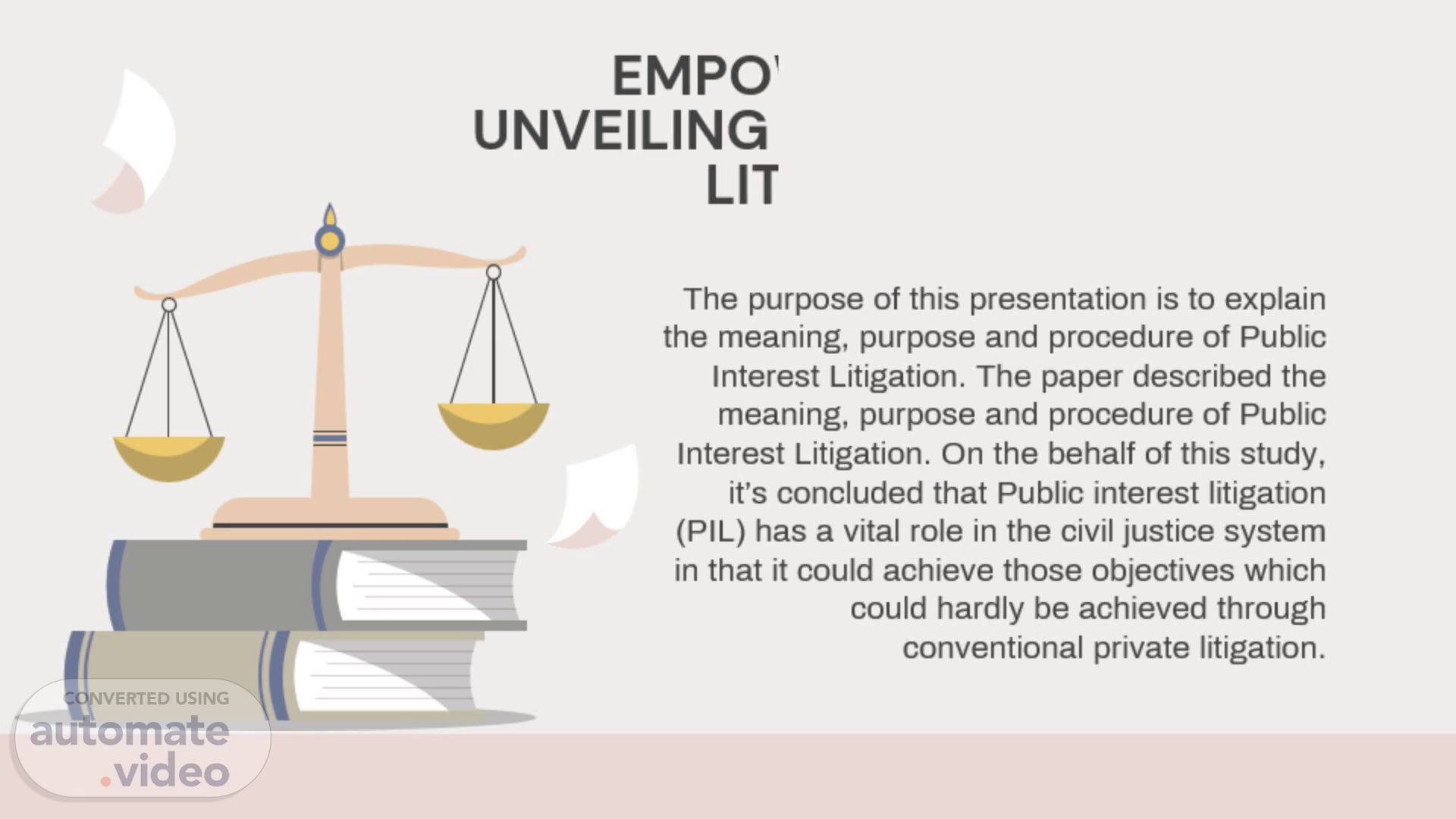
EMPOWERING JUSTICE: UNVEILING PUBLIC INTEREST LITIGATION IN INDIA
Scene 1 (0s)
undefined. EMPOWERING JUSTICE: UNVEILING PUBLIC INTEREST LITIGATION IN INDIA.
Scene 2 (21s)
Public Interest Litigation (PIL) was conceived to protect the rights of the socially and economically disadvantaged. Unlike typical litigation, PIL does not involve private disputes but centers on issues of public interest. It represents a judicial strategy aimed at bridging societal gaps and promoting social welfare.Public Interest Litigation (PIL) is a legal mechanism where court actions are initiated to uphold public or community interests that affect their legal rights or obligations. Unlike conventional lawsuits, PIL is not pursued for personal benefit but serves as a vital tool within the legal aid movement. It aims to provide justice to thosesystem. who lack individual access to the judicial.
Scene 3 (51s)
Factors Responsible for the Growth of PIL in India.
Scene 4 (1m 23s)
Who Can File a PIL and Against Whom?. WHO CAN FILE PIL.
Scene 5 (2m 7s)
In Public Interest Litigation (PIL), the locus standi rule is relaxed compared to traditional cases. It allows individuals and organizations to petition the court on behalf of others or issues of public interest, even if they are not directly affected themselves. This ensures broader access to justice and enables the courts to address systemic issues and protect fundamental rights effectively..
Scene 6 (2m 27s)
ESSENTIALS OF PIL. Justice Bhagwati in S.P. Gupta’s case pointed out the essentials of PIL, as under a) There must be a legal wrong caused to a person or to a determinate class of person, on whom burden is imposed in violation of law or without legal authority. b) The wrong must arise from violation of any constitutional or legal right. c) The wronged person (or determinate group of persons) must be unable to approach court for relief by reason of – (i) poverty, (ii) helplessness; or (iii) social or economic disability or socially or economically disadvantaged person. d) If the above conditions are satisfactory, then any member of the public can seek judicial relief for the above wrong. e) But the court should be anxious to ensure that the person initiated the proceeding to acting bonafide to get redress for a public grievance and not to pursue personal gains or from malicious motives. f) If the case is otherwise appropriate for PIL then the court can act even on letter addressed to it. (SP Gupta Vs Union of India, AIR 1982SC 149).
Scene 7 (3m 9s)
Evolution of PIL in India: Some Landmark Judgements.
Scene 8 (4m 28s)
SIGNIFICANCE OF PIL. It is an important tool to make human rights reach those who have been denied rights. It democratises the access of justice to all. Any citizen or organisation who is capable can file petitions on behalf of those who cannot or do not have the means to do so..
Scene 9 (5m 7s)
CERTAIN WEAKNESSES OF PIL. PIL matters concerning the exploited and disadvantaged groups are pending for many years. Inordinate delays in the disposal of PIL cases may render many leading judgments merely of academic value..
Scene 10 (5m 45s)
JUDICIAL ACTIVISM AND PUBLIC INTEREST LITIGATION IN INDIA.
Scene 11 (6m 30s)
CONCLUSION Public Interest Litigation (PIL) has made significant strides by providing relief to marginalized groups such as bonded laborers, undertrials, women prisoners, and other vulnerable populations through judicial intervention.PIL has notably enhanced government accountability for the rights of the poor and established legal norms for addressing constitutional and legal violations affecting marginalized communities.However, caution is essential to prevent Judicial Overreach and maintain the principle of Separation of Powers in PIL cases. Efforts should also focus on discouraging frivolous PILs driven by personal interests to ensure the judicial system efficiently serves the public interest..
Scene 12 (6m 57s)
THANK YOU. SONIA ATTRI UNIVERSITY OF DELHI, FACULTY OF LAW.